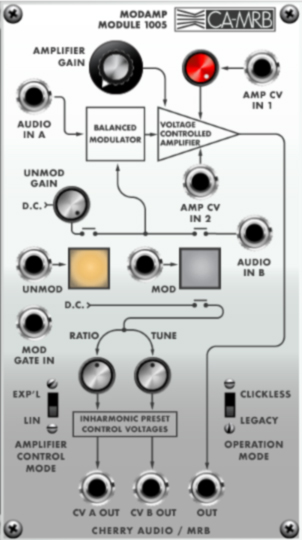
The 1005 Modamp performs a couple functions, but it's mainly a "balanced modulator," (aka, ring modulator). If two waves are input, the output contains only the sum and difference frequencies, but removes the original. The audio result is useful for creating sounds with inharmonic frequency content, which is useful for synthesizing bell and metallic sounds (but not that useful for creating the sounds of Metallica, which nobody wants anyway).
Though the front panel says "balanced modulator," this effect is almost always referred to as "ring modulation" these days, so we'll call it that.
Inputs, Outputs, and Controls
Audio In A / Audio In B- Patch the two signals to be combined into these jacks. Plug signals into Audio In A to use Modamp 1005 as a conventional VCA.
Amplifier Gain- Sets the VCA initial gain level. Set this to zero if an envelope generator is being used to modulate VCA level.
Amp CV In 1 / Amp CV In 2- These are CV mod inputs for the VCA stage. Amp CV In 1 includes an attenuator; Amp CV In 2 is always at full with not attenuation. Amp CV 2 is useful with an envelope generator, whereas Amp CV 1's attenuator is useful with LFOs or other mod sources.
Unmod/Mod buttons and CV jacks- These enable (Mod) and disable (Unmod) ring modulation when they receive a trigger or gate voltage.
Unmod Gain- Sets an initial level for Audio In A when ring mod is disabled (i.e. Unmod mode). This is useful for balancing level between Mod and Unmod modes. (It won't help you when listening to Depeche Mode... I mean, can anyone really help them since Wilder left?)
BTW, the D.C. labels refer to the direct current voltage applied to the ring modulator when only one audio source is present (aka Unmod mode). This voltage is applied to the unused input in order to allow the Audio In A signal to pass; without it, sound wouldn't be able to pass through the ring mod processor.
Amplifier Control Mode / Exponential/Linear- Changes the VCA response from linear (constant rate of change as control voltage rises) to exponential response (rate of change increases as voltage increases - this is how the human ear works). General speaking, exponential mode is used when the VCA is regulating the volume of a signal (typically in conjunction with an envelope generator), and linear mode is used when the VCA is regulating a CV (a mod wheel routed to a VCA CV in regulating how much LFO signal is routed to pitch, for example).
Inharmonic Preset Control Voltages / Ratio/Tune / CV A Out / CV B Out- This one's a little kooky, but relatively simple, so bear with us - remember that it was still the wild west in synth design when the original 2500 was designed. As you may have noticed, the Modamp module was designed with the premise that the user would frequently switch between Mod and Unmod modes, that is, enabling and disabling ring mod. Because ring mod can wildly affect tuning, these "extra" CV outs to allow users to (sort of) match up pitches for harmonically seamless transition between ring mod on and off modes. With that in mind, Inharmonic Preset Control Voltages CV outs are only active when Mod is enabled - they have no output when Unmod is engaged (i.e. ring mod off).
To use this feature, patch CV A Out to the frequency CV of the oscillator patched to Audio In A, and CV B Out to the frequency CV in of the oscillator patched to Audio In B (open up the corresponding freq CV attenuators all the way on the oscillators). Now switch back and forth between Mod and Unmod and use the Ratio and Tune knobs to match the pitch when in Unmod mode.
Mod Gate In- This is similar to the Unmod and Mod switch CV ins, but allows switching back and forth with one CV source. Typically this would be used with an LFO pulse or square wave; when the voltage is high, Mod mode is engaged, when the voltage is 0V, Unmod is engaged.
The nifty part is that it can switch REALLY fast - try patching an oscillator running in audio range for a smorgasbord of dastardly overtones. Keep reading, because the next switch is important...
Operation Mode / Clickless/Legacy- When set to Clickless mode, a tiny crossfade is added when switching between Unmod and Mod modes with the buttons, CV inputs, or the Mod Gate In to prevent clicking artifacts. The clicking between modes isn't all that noticeable when switching slowly, but it adds ugly artifacts as mod rates are increased. This feature is not present on the original 2500 Modamp, we've included a Legacy (no crossfade) mode for vintage correctness. (BTW, Cliqueless Mode had a huge new wave hit in France in 1981, and followed it with a huge tour featuring Trans-X and Pseudo Echo.)
Out- Output of all signals.